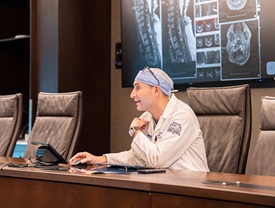Treatments

We provide treatment options for many tumors of the spine and spinal cord.
If you’ve been diagnosed with a spinal tumor or spinal cord tumor, time is critical. You need the most effective treatment as quickly as possible.
Our team is a leader in spinal cancer treatment. Our advanced techniques and technology mean patients have fewer complications and a faster recovery after their care.
What are the different types of spinal cancer?
There are two main categories of spinal cancer -- spinal tumors and spinal cord tumors.
Spinal tumors grow within the spinal canal or the bone of the spine. You also may hear this referred to as a “bony tumor.” Spinal tumors can be benign (noncancerous) or malignant (cancerous). These tumors often have spread to the spine from another area of the body (known as metastatic cancer).
Spinal cord tumors begin on the spinal cord itself. There are two main types of spinal cord tumors. Intramedullary tumors, such as astrocytomas or ependymomas, begin in the cells within the spinal cord. Extramedullary tumors develop within the supporting network of cells around the spinal cord. Extramedullary tumors can affect spinal cord function by causing spinal cord compression and other problems, including back pain and loss of sensation in the arms or legs.
Should I worry if I have a benign spinal tumor?
In some cases, benign spinal tumors can be as dangerous as malignant ones -- sometimes even more dangerous. The spine and spinal cord play an important role in movement and other bodily functions. Benign tumors in certain areas of the spine can affect:
- Bladder and bowel function
- Breathing
- Sensory function (the ability to perceive the world around you)
- Motor function (the ability to move)
Even if a benign tumor isn’t located in an area of the spine that controls critical functions, it still can be very dangerous. Benign tumors sometimes can grow quickly, which can compress the spine. Spinal compression can make it difficult or impossible to move without treatment.
What are my options for spinal cancer treatment?
In addition to chemotherapy, the main treatment options we offer for spinal tumors and spinal cord tumors are radiosurgery and minimally invasive spine surgery.
Radiosurgery
Radiosurgery is the use of radiation to shrink or destroy tumors, as well as prevent them from growing. We offer radiosurgery for spinal and spinal cord tumors at Henry Ford Hospital in Detroit and Henry Ford West Bloomfield Hospital in West Bloomfield, Mich. Radiosurgery is one of our radiation oncology services.
In the 1990s, Henry Ford was the first healthcare provider in the world to use radiosurgery for spinal and spinal cord tumors. Today, our technology allows for extremely precise treatment of tumors that are close to the spinal cord with less risk of radiation exposure to healthy tissue.
The vast majority of our radiosurgery patients experience good outcomes after treatment:
- 85 to 90 percent of radiosurgery patients have significant improvement in pain and pain control
- One year after treatment, about 85 percent of patients continue to have improved pain relief and pain control
- More than 90 percent of patients experience epidermal tumor (tumors that grow in the bones of the spine) control or decompression (pulling the tumor off the spine). In most cases, tumors decreased by 66 percent on average.
We may recommend radiosurgery for patients who have:
- Full leg strength, or normal function
- The ability to move their legs against normal gravity with minimal resistance
- Imaging scans that show no structural damage to the spine
Minimally invasive spine surgery
Surgery to treat spinal and spinal cord tumors is a complex procedure. Our spinal cancer surgeons use highly detailed imaging and robot-assisted positioning systems. This technology has several benefits in minimally invasive spine surgery, such as:
- Better precision for surgeons to avoid important structures during surgery
- Faster recovery time
We can even track how your nerves are functioning during surgery to minimize the chance of complications after the procedure. Our surgeons use a test called an electromyogram, or EMG, to record electrical activity in the muscles or the speed and strength of a signal that travels between two points on a nerve. This gives our doctors even more precision and control during your surgery.
We often recommend surgery for patients who have:
- Significant neurological deficits and decreased motor function (you have difficulty walking, or weakness and numbness in the legs)
- Structural issues with the spine caused by a spinal tumor or spinal cord tumor
- A tumor that has caused a compression fracture (fragments of the spine are being pushed into the spinal cord)
- Dramatic spinal cord instability (when the spinal vertebrae aren’t aligned)
What treatment is best for my type of tumor?
Each patient is different. Each tumor is different too.
For example, we remove benign (non-cancerous) tumors surgically, but they don’t need radiation or chemotherapy. Approximately 99 percent of these tumors never return after surgical removal. Malignant (cancerous) tumors may respond to surgery or radiosurgery, and patients also may need chemotherapy or radiosurgery after their initial treatment to have the best possible outcome.
The size of your tumor may influence our treatment recommendations. If your tumor is small, radiosurgery may be the better choice. Larger tumors or tumors that are causing spinal cord compression may require surgery.
The future of spinal cancer treatment
We don’t believe in a one-size-fits-all approach to cancer care. And we continue to make advancements in tailored treatment -- the idea that cancer care can be designed exclusively for a specific patient. One way we can do that is through gene therapy studies.
Gene therapy studies will allow us to know the genetic makeup of a patient’s tumor. We should be able to use this information to offer personalized medicine. We hope to know the outcome of a treatment plan before we start, based on the patient’s DNA
.svg?iar=0&hash=F6049510E33E4E6D8196C26CCC0A64A4)

/hfh-logo-main--white.svg?iar=0&hash=ED491CBFADFB7670FAE94559C98D7798)